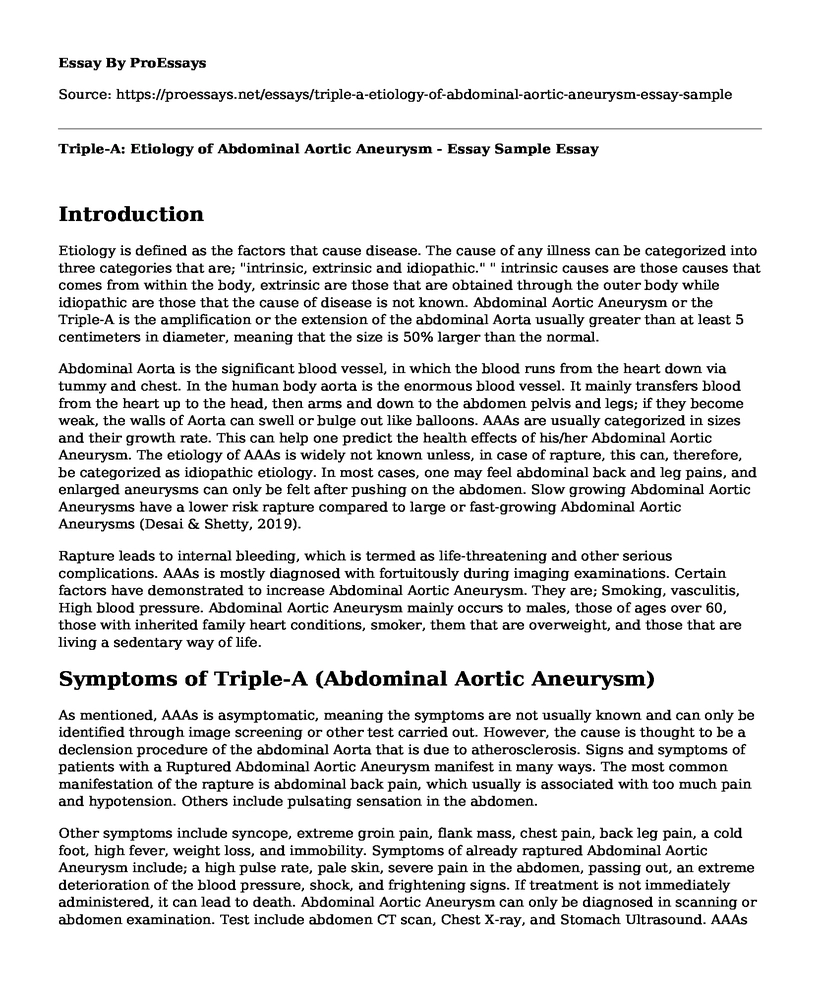Introduction
Etiology is defined as the factors that cause disease. The cause of any illness can be categorized into three categories that are; "intrinsic, extrinsic and idiopathic." " intrinsic causes are those causes that comes from within the body, extrinsic are those that are obtained through the outer body while idiopathic are those that the cause of disease is not known. Abdominal Aortic Aneurysm or the Triple-A is the amplification or the extension of the abdominal Aorta usually greater than at least 5 centimeters in diameter, meaning that the size is 50% larger than the normal.
Abdominal Aorta is the significant blood vessel, in which the blood runs from the heart down via tummy and chest. In the human body aorta is the enormous blood vessel. It mainly transfers blood from the heart up to the head, then arms and down to the abdomen pelvis and legs; if they become weak, the walls of Aorta can swell or bulge out like balloons. AAAs are usually categorized in sizes and their growth rate. This can help one predict the health effects of his/her Abdominal Aortic Aneurysm. The etiology of AAAs is widely not known unless, in case of rapture, this can, therefore, be categorized as idiopathic etiology. In most cases, one may feel abdominal back and leg pains, and enlarged aneurysms can only be felt after pushing on the abdomen. Slow growing Abdominal Aortic Aneurysms have a lower risk rapture compared to large or fast-growing Abdominal Aortic Aneurysms (Desai & Shetty, 2019).
Rapture leads to internal bleeding, which is termed as life-threatening and other serious complications. AAAs is mostly diagnosed with fortuitously during imaging examinations. Certain factors have demonstrated to increase Abdominal Aortic Aneurysm. They are; Smoking, vasculitis, High blood pressure. Abdominal Aortic Aneurysm mainly occurs to males, those of ages over 60, those with inherited family heart conditions, smoker, them that are overweight, and those that are living a sedentary way of life.
Symptoms of Triple-A (Abdominal Aortic Aneurysm)
As mentioned, AAAs is asymptomatic, meaning the symptoms are not usually known and can only be identified through image screening or other test carried out. However, the cause is thought to be a declension procedure of the abdominal Aorta that is due to atherosclerosis. Signs and symptoms of patients with a Ruptured Abdominal Aortic Aneurysm manifest in many ways. The most common manifestation of the rapture is abdominal back pain, which usually is associated with too much pain and hypotension. Others include pulsating sensation in the abdomen.
Other symptoms include syncope, extreme groin pain, flank mass, chest pain, back leg pain, a cold foot, high fever, weight loss, and immobility. Symptoms of already raptured Abdominal Aortic Aneurysm include; a high pulse rate, pale skin, severe pain in the abdomen, passing out, an extreme deterioration of the blood pressure, shock, and frightening signs. If treatment is not immediately administered, it can lead to death. Abdominal Aortic Aneurysm can only be diagnosed in scanning or abdomen examination. Test include abdomen CT scan, Chest X-ray, and Stomach Ultrasound. AAAs can only be treated through surgery. The surgery depends on the overall health and the type of aneurysm. If the AAA is large, the doctor may use open abdominal surgery to erase the damaged parts of the Aorta. If the Aorta is weak, the doctor may use Endovascular surgery. If the AAA is small, the doctor will monitor instead of performing any operation (Ramos & Benarroch-Gampel, 2020).
Conclusion
In conclusion, to control Abdominal Aortic Aneurysm, one needs to observe diet and also do exercise regularly. In case of any rapture on one needs to seek immediate medical attention, even though signs and symptoms of AAAs are not known, one should seek medical examination in case of the other mentioned symptoms.
References
Angiletta, D., Wiesel, P., Mastrangelo, G., Tedesco, M., Zaca, S., Marinazzo, D., & Pulli, R. (2020). Endovascular treatment of multiples ruptures of post-dissecting thoraco abdominal aortic aneurysm with a custom branched device used as an off the shelf. Annals of Vascular Surgery.
Desai, S. C., Gangadharan, A. N., Basavanthappa, R. P., Ramswamy, C. A., & Shetty, R. (2019). Giant abdominal aortic aneurysm of uncommon etiology due to Behcet disease. Journal of vascular surgery, 70(3), 937-940.
Ramos, C., Pujari, A., Rajani, R. R., Escobar, G. A., Rubin, B. G., Jordan Jr, W. D., & Benarroch-Gampel, J. (2020). Perioperative Outcomes for Abdominal Aortic Aneurysm Repair Based on Aneurysm Diameter. Vascular and Endovascular Surgery, 1538574420909635.
Cite this page
Triple-A: Etiology of Abdominal Aortic Aneurysm - Essay Sample. (2023, May 18). Retrieved from https://proessays.net/essays/triple-a-etiology-of-abdominal-aortic-aneurysm-essay-sample
If you are the original author of this essay and no longer wish to have it published on the ProEssays website, please click below to request its removal:
- Research Paper on Impact of Painkillers In The Urinary Tract Infections (UTI)
- Informed Consent for Mentally Incapacitated Patients Essay
- Essay on Health Administrators: Challenges & Solutions in a Brain Death Scenario
- Essay Example on Robotic Companions: The Future of Human Life?
- Executive Summary for Administration of a University Medical Center
- Managing Interruptions in Medical Administration: A Critical Analysis and Practical Solutions - Paper Sample
- COVID-19 and Prison System - Report Example







